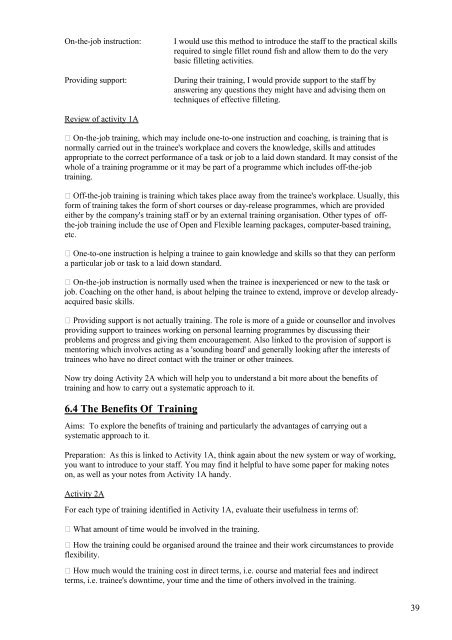How to Perform On-the-job Training - Dean Amory
According to The Encyclopedia of Business, ©2000 Gale Cengage, On-the-job training is by far the predominant form of job training. Studies also indicate that it is the most effective form of job training. Yet, it also represents a significant investment considering that roughly 30% of a new worker's time is spent in on-the-job training during the first 90 days of employment, that productivity of experienced workers assigned to train new workers may decrease during the training period, and that new workers may make expensive mistakes. Both companies and workers therefore profit largely from the presence of simple, but complete trainee and trainer guides that allow for executing OJT in a structured way. “How to perform on-the-job training”, has the information, techniques and tips that will allow you to implement a professional OJT training program. The book also includes all the tools, documents and checklists necessary for setting up a qualitative and efficient skills training program for OJT coaches
According to The Encyclopedia of Business, ©2000 Gale Cengage, On-the-job training is by far the predominant form of job training. Studies also indicate that it is the most effective form of job training. Yet, it also represents a significant investment considering that roughly 30% of a new worker's time is spent in on-the-job training during the first 90 days of employment, that productivity of experienced workers assigned to train new workers may decrease during the training period, and that new workers may make expensive mistakes.
Both companies and workers therefore profit largely from the presence of simple, but complete trainee and trainer guides that allow for executing OJT in a structured way.
“How to perform on-the-job training”, has the information, techniques and tips that will allow you to implement a professional OJT training program. The book also includes all the tools, documents and checklists necessary for setting up a qualitative and efficient skills training program for OJT coaches
Create successful ePaper yourself
Turn your PDF publications into a flip-book with our unique Google optimized e-Paper software.
<strong>On</strong>-<strong>the</strong>-<strong>job</strong> instruction: I would use this method <strong>to</strong> introduce <strong>the</strong> staff <strong>to</strong> <strong>the</strong> practical skills<br />
required <strong>to</strong> single fillet round fish and allow <strong>the</strong>m <strong>to</strong> do <strong>the</strong> very<br />
basic filleting activities.<br />
Providing support: During <strong>the</strong>ir training, I would provide support <strong>to</strong> <strong>the</strong> staff by<br />
answering any questions <strong>the</strong>y might have and advising <strong>the</strong>m on<br />
techniques of effective filleting.<br />
Review of activity 1A<br />
<strong>On</strong>-<strong>the</strong>-<strong>job</strong> training, which may include one-<strong>to</strong>-one instruction and coaching, is training that is<br />
normally carried out in <strong>the</strong> trainee's workplace and covers <strong>the</strong> knowledge, skills and attitudes<br />
appropriate <strong>to</strong> <strong>the</strong> correct performance of a task or <strong>job</strong> <strong>to</strong> a laid down standard. It may consist of <strong>the</strong><br />
whole of a training programme or it may be part of a programme which includes off-<strong>the</strong>-<strong>job</strong><br />
training.<br />
Off-<strong>the</strong>-<strong>job</strong> training is training which takes place away from <strong>the</strong> trainee's workplace. Usually, this<br />
form of training takes <strong>the</strong> form of short courses or day-release programmes, which are provided<br />
ei<strong>the</strong>r by <strong>the</strong> company's training staff or by an external training organisation. O<strong>the</strong>r types of off<strong>the</strong>-<strong>job</strong><br />
training include <strong>the</strong> use of Open and Flexible learning packages, computer-based training,<br />
etc.<br />
<strong>On</strong>e-<strong>to</strong>-one instruction is helping a trainee <strong>to</strong> gain knowledge and skills so that <strong>the</strong>y can perform<br />
a particular <strong>job</strong> or task <strong>to</strong> a laid down standard.<br />
<strong>On</strong>-<strong>the</strong>-<strong>job</strong> instruction is normally used when <strong>the</strong> trainee is inexperienced or new <strong>to</strong> <strong>the</strong> task or<br />
<strong>job</strong>. Coaching on <strong>the</strong> o<strong>the</strong>r hand, is about helping <strong>the</strong> trainee <strong>to</strong> extend, improve or develop alreadyacquired<br />
basic skills.<br />
Providing support is not actually training. The role is more of a guide or counsellor and involves<br />
providing support <strong>to</strong> trainees working on personal learning programmes by discussing <strong>the</strong>ir<br />
problems and progress and giving <strong>the</strong>m encouragement. Also linked <strong>to</strong> <strong>the</strong> provision of support is<br />
men<strong>to</strong>ring which involves acting as a 'sounding board' and generally looking after <strong>the</strong> interests of<br />
trainees who have no direct contact with <strong>the</strong> trainer or o<strong>the</strong>r trainees.<br />
Now try doing Activity 2A which will help you <strong>to</strong> understand a bit more about <strong>the</strong> benefits of<br />
training and how <strong>to</strong> carry out a systematic approach <strong>to</strong> it.<br />
6.4 The Benefits Of <strong>Training</strong><br />
Aims: To explore <strong>the</strong> benefits of training and particularly <strong>the</strong> advantages of carrying out a<br />
systematic approach <strong>to</strong> it.<br />
Preparation: As this is linked <strong>to</strong> Activity 1A, think again about <strong>the</strong> new system or way of working,<br />
you want <strong>to</strong> introduce <strong>to</strong> your staff. You may find it helpful <strong>to</strong> have some paper for making notes<br />
on, as well as your notes from Activity 1A handy.<br />
Activity 2A<br />
For each type of training identified in Activity 1A, evaluate <strong>the</strong>ir usefulness in terms of:<br />
What amount of time would be involved in <strong>the</strong> training.<br />
<strong>How</strong> <strong>the</strong> training could be organised around <strong>the</strong> trainee and <strong>the</strong>ir work circumstances <strong>to</strong> provide<br />
flexibility.<br />
<strong>How</strong> much would <strong>the</strong> training cost in direct terms, i.e. course and material fees and indirect<br />
terms, i.e. trainee's downtime, your time and <strong>the</strong> time of o<strong>the</strong>rs involved in <strong>the</strong> training.<br />
39


















